The Latest in Gardening Research: Hedge-Trimming Robots, Super Roots, and Milkweeds of the Future
February 22nd, 2022
Let’s catch up this week on some of the latest gardening research that might impact how we grow…
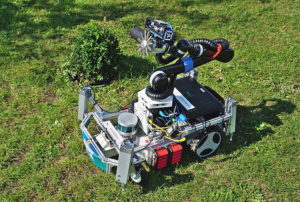
The European TrimBot2020.
Credit: Elsevier/ScienceDirect
A Hedge-Trimming Robot?
We already have robots that vacuum our floors, mow our lawns, and even weed our gardens, so is a robot that trims our bushes and hedges next?
Researchers in Scotland, the Netherlands, Germany, and Switzerland are evaluating a prototype hedge-trimming robot called the European TrimBot2020 that’s a wheeled machine fitted with eight cameras and a robotic arm with trimmers at the business end.
In its first European real-world trial, TrimBot2020 was assigned to trim boxwoods into three different shapes – spheres, cylinders, and cubes.
The initial results were underwhelming, according to a paper in this month’s issue of Biosystems Engineering.
In both 3D computer assessments and evaluations by 10 humans, the best rating TrimBot2020 could muster was 3.1 out of 5.
“The poor trimming performance, in particular for cylindrical and cuboid shapes, indicates that the trimming result of the mobile robot is not yet accurate enough for practical application of trimming complex shapes,” the researchers concluded.
They added that the trial was helpful, though, in identifying “bottlenecks and weak points” to tweak TrimBot’s future performance.
Automated plant-trimming machines already are used in some nursery productions, but those use GPS to trim mechanically without any sensory feedback.
The trick in developing a robot for garden settings is figuring out how to navigate varying terrain and how to have a robot assess how it’s doing as it manipulates the bushes into the desired shapes.
The Quest for Bigger, Better Roots
Research that turned out more promising came from Penn State University, where researchers isolated a genetic trait in corn and wheat that causes their roots to penetrate better into compacted soil. The trait could lead the way to new varieties that grow and yield better.
A team led by plant-science professor Dr. Jonathan Lynch used a three-dimensional, microscopic, visualization tool called laser ablation tomography to analyze the root makeup of corn and wheat plants that did naturally better than their neighbors in growing in compacted soil.
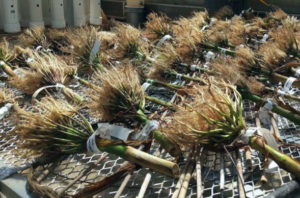
Roots being analyzed at Penn State.
Credit: Hannah Schneider/Penn State University
The researchers found that plants with a genetic trait called MCS (multiseriate cortical sclerenchyma) developed more lignin in their cell walls, which in turn made the roots more rigid and their tips stronger.
These extra-strong roots penetrated 22 percent deeper and resulted in plants growing 39 percent bigger.
Lynch said that’s a big plus for drought tolerance, nutrient use, and ultimately, better yields, especially in areas negatively affected by climate change.
“Breeding for this trait should be helpful in developing new crops for climate mitigation,” he said.
Penn State’s novel work in analyzing roots opens the door to finding traits in other plants that could lead to better yields in other edibles, including those grown in home gardens.
Better-Looking Milkweeds?
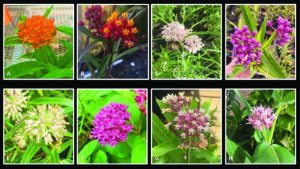
Eight milkweed species that were used in the Georgia study.
Credit: HortScience
Milkweeds are superplants for butterflies (especially monarchs), but they’re not the most popular home-garden plant because of their not-so-showy flowers and gangly growth habits.
Researchers at the University of Georgia and Ball Horticultural Co. teamed up to try and figure out a way to cross-pollinate different milkweed species in an effort to pave the way to new hybrid milkweeds that both look good in gardens and benefit pollinators.
The researchers used the most garden-friendly current milkweed – the orange-blooming butterfly weed or Asclepias tuberosa – as the mother plant for crosses with seven other milkweed species, including showy milkweed, common milkweed, purple milkweed, and green milkweed.
In a paper published in HortScience, the researchers reported that a pollination technique that they described as similar to inserting a key in a lock resulted in a success rate that jumped from 2 percent to 11 percent over traditional pollinating.
Using that and exposing the seed to cold, moist conditions prior to germinating “provide a starting point for future breeding efforts of Asclepias and showcase the potential of introducing novel or improved cultivars of Asclepias to the commercial market,” the researchers concluded.
With 106 varieties of milkweed native to North America, breeders will have lots of choices to explore.
Developing new milkweed varieties has been difficult up to now because of the species’ complex reproductive system.
The Best Native Hydrangeas
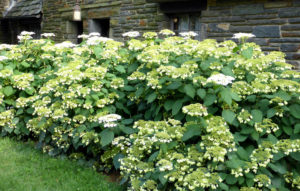
‘Haas’ Halo’ scored a top five-star rating in Mt. Cuba’s trials.
Delaware’s Mt. Cuba Center just completed a five-year study aimed at helping gardeners in the mid-Atlantic region zero in on the best types of native hydrangeas.
The Hockessin display and research garden evaluated 29 species and varieties of native smooth, ashy, and silver-leaf hydrangeas (Hydrangea arborescens, H. cinerea, and H. radiata) and identified nine as the top performers.
‘Haas’ Halo’ topped the list as the only perfect, five-star performer, followed by the varieties Lime Rickey, Incrediball Blush, Invincibelle Spirit II, Incrediball, ‘Bounty,’ White Dome, ‘Mary Nell,’ and ‘Total Eclipse.’
Mt. Cuba also looked at which varieties were best at attracting pollinators (a key desired trait lately among gardeners) and identified a top five of White Dome, the straight Hydrangea arborescens species, ‘Total Eclipse,’ ‘Pink Pincushion,’ and ‘Haas’ Halo.’
Most of the hydrangeas in the trial performed best in shade to partly shaded conditions with moist soil – or at least out of full sun and dry soil.
The hydrangea study is the latest in Mt. Cuba’s series of native-plant trials. The results of past trials, including coneflowers, phlox, bee balm, baptisia, and coreopsis, are posted on Mt. Cuba’s Trial Garden page.
“Bluemuda” for Pa. lawns?
Bermudagrass is a widely used type of grass in the South because it survives high heat, needs little water, grows in poor soil, tolerates foot traffic, and grows thickly and quickly.
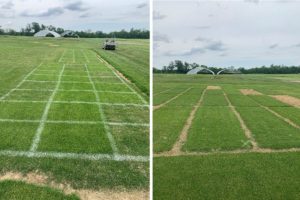
Trial plots featuring a blend of Kentucky bluegrass and bermudagrass.
Credit: Tanner Delvalle
It’s never caught on in the North because it goes straw-brown in cold weather – or dies completely in our winters.
Now that our climate is warming and researchers have developed cold-hardier types of bermudagrass, Penn State University turf researchers are looking at whether bermudagrass might now make sense here – at least on golf courses and athletic fields.
A 2020-2021 experiment at Penn State’s University Park and Berks campuses interplanted a cold-hardy, hybrid variety of bermudagrass called Tahoma 31 with our traditional Kentucky bluegrass.
Dubbed “bluemuda,” this tag-team approach is finding that Tahoma 31 is durable and dominant in the summer lawn while the Kentucky bluegrass then provides a green cover from fall through the following late spring while the bermudagrass is dormant.
“The jury is still out on if you will see this combination here,” says Tanner Delvalle, a Penn State Extension educator in Schuylkill and Berks counties and one of the study’s researchers.
He says one main hurdle is that bluegrass is probably going to have to be overseeded into the stand each fall.
“What I do think you will see – and is already happening – is the use of 100 percent bermudagrass for sports fields,” Delvalle says. “There are a few bermudagrass fields in Pennsylvania but dozens in Maryland. The folks that have them, love them.”
Even if sports fields start using the bluemuda tag-team approach, Delvalle doesn’t see the idea catching on in home lawns anytime soon.
Besides needing to overseed each year, most homeowners probably aren’t going to like the brown, dormant winter-time look of bermudagrass.
“The color in the winter is something we are not used to,” Delvalle says. “Zoysia is the same way, but it’s more cold tolerant.”
He adds that bermudagrass also can “run” and seed where it’s not wanted, which makes it more of a weed potential in home landscapes than in expansive sports fields.
For homeowners trying to find a type of grass that’s tougher in heat, drought, and foot traffic than our traditional mix of Kentucky bluegrass, perennial ryegrass, and fine fescues, Delvalle suggests turf-type tall fescue.
New varieties of that grass type are finer and greener than older types of tall fescue, and they don’t go brown all winter like bermudagrass or Zoysia.
More Gardening, Less Stress
Lots of anecdotal evidence has popped up during the past two COVID-laced years that our gardens have been an important source of solace and sanity.
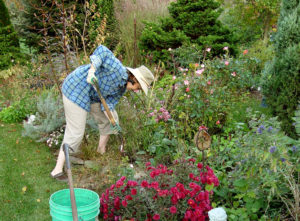
More gardening and more plants apparently translate into less stress and happier people.
A 2021 study out of England, funded by the Royal Horticultural Society and published in “Cities: The International Journal of Urban Policy and Planning,” claims to be the first to show a “dose-related” benefit to gardening.
Researchers analyzed the pre-COVID questionnaires of more than 6,000 Brits, comparing how often people gardened to their self-reported feelings of well-being and stress.
“Significant improvements in well-being, reductions in perceived stress, and greater physical activity were all strongly associated with more frequent gardening,” the researchers concluded. Daily gardeners reported nearly seven percent higher well-being scores and 4.2 percent lower stress scores than those who didn’t garden.
When asked if gardening offered any therapeutic benefits, gardeners cited these: relaxation (20 percent), stress relief (16 percent), space for reflection (14 percent), help with episodes of depression (13 percent), physical exercise (13 percent), a sense of well-being (13 percent), and a boost in energy levels (12 percent).
The study also found that the more plants people had in their front yards, the happier they were. For each additional 10 percent of plant cover in the front yard, happiness scores went up 26 percent.
Despite those health-related pluses, gardeners said they weren’t gardening mainly for health reasons.
The direct pleasure of gardening was the No. 1 reason given, with related reasons such as “love of the activity” and “seeing plants and/or flowers grow” scoring higher than health benefits, which finished in the middle of the pack.







